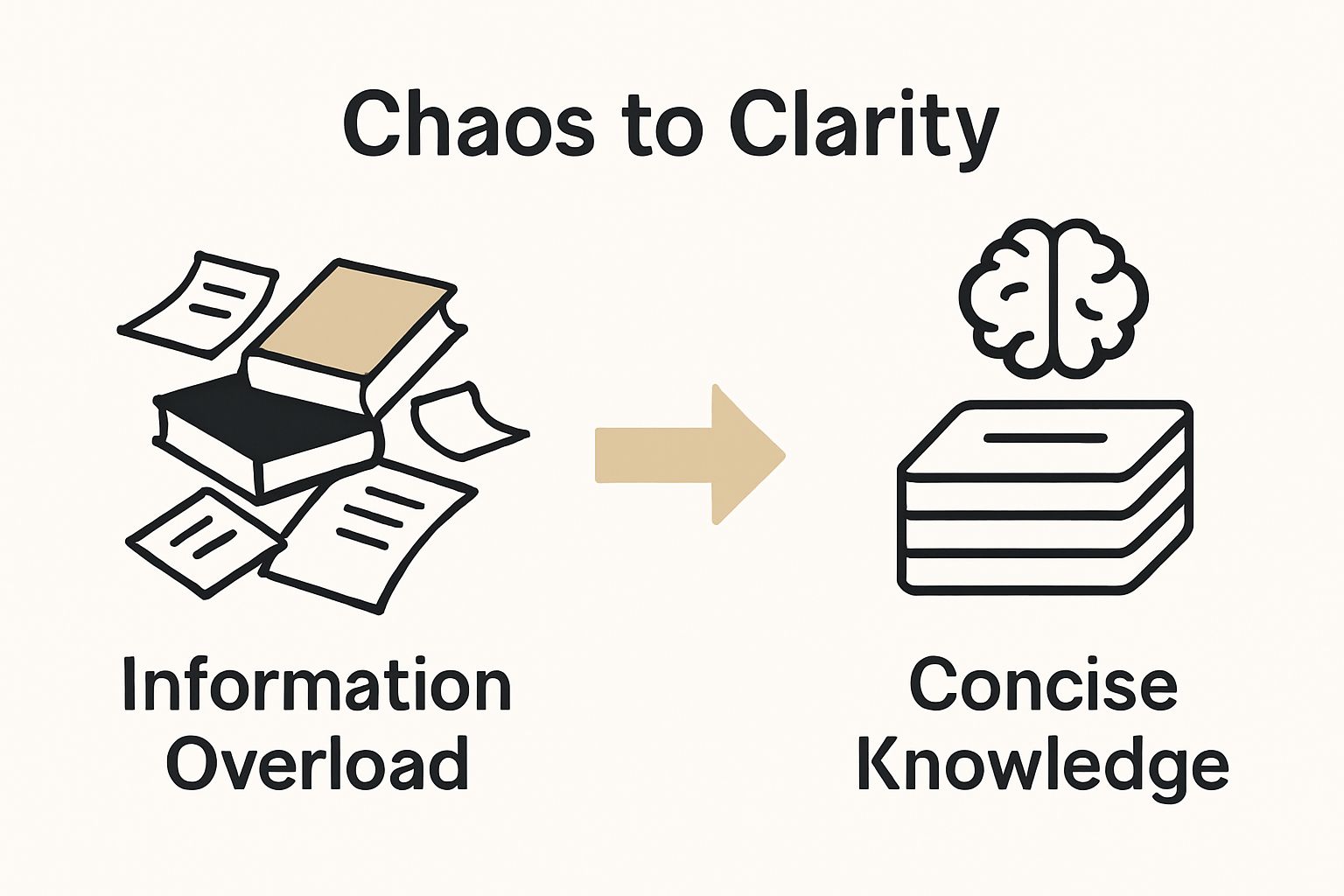Understanding the Role of Concise Summaries in Education

Everyone talks about how to learn faster, but most people drown in too much information. In fact, studies show concise summaries can dramatically enhance memory and reading comprehension. So why do traditional study methods still focus on reading everything in full? The real secret lies in cutting out the clutter and zeroing in on what actually matters.
Table of Contents
- The Concept Of Concise Summaries In Learning
- Importance Of Summarization For Understanding Information
- How Concise Summaries Enhance Retention And Recall
- Applications Of Concise Summaries In Different Educational Contexts
- Real-World Examples And Impact Of Effective Summarization
Quick Summary
| Takeaway | Explanation |
|---|---|
| Concise summaries improve learning efficiency | Summarization condenses complex information, making it easier for learners to retain and understand key concepts. |
| Engaging in summarization fosters critical thinking | Creating summaries requires analysis and evaluation, enhancing learners’ critical thinking skills and deep comprehension of the material. |
| Neurological processes enhance memory retention | Summarization activates brain regions crucial for memory, aiding in the encoding, storing, and recalling of information. |
| Applications span educational and professional contexts | Summarization techniques are beneficial across various environments, from classrooms to workplaces, facilitating effective communication and knowledge transfer. |
| Summarization is a powerful cognitive strategy | By filtering essential content from excess information, summarization aids in navigating modern information overload effectively. |
The Concept of Concise Summaries in Learning
Concise summaries represent a powerful cognitive tool that transforms complex information into digestible, comprehensible segments. At its core, this learning technique involves extracting and consolidating the most critical ideas from extensive content, enabling learners to grasp essential concepts quickly and efficiently.
Understanding Information Reduction
Learning through concise summaries is fundamentally about cognitive efficiency. Research from cognitive psychology demonstrates that the human brain processes and retains information more effectively when it is presented in condensed, structured formats. By reducing cognitive load, summaries help learners focus on key insights without getting overwhelmed by excessive details.
The process involves several critical cognitive mechanisms:
- Identifying primary concepts and arguments
- Eliminating redundant or peripheral information
- Restructuring knowledge into a more compact representation
- Enhancing comprehension through strategic information distillation
Cognitive Benefits of Summarization
Summarization is more than a passive reading technique. It actively engages learners in critical thinking, requiring them to analyze, evaluate, and synthesize information. When students create summaries, they must deeply understand the material to determine what content is most significant.
This active engagement triggers multiple cognitive processes that enhance learning:
- Improved information retention
- Enhanced analytical thinking skills
- Better long-term memory consolidation
- Increased ability to connect complex ideas
For those interested in exploring more about effective communication through summaries, our guide on understanding concise summaries offers additional insights into this powerful learning strategy.
Importance of Summarization for Understanding Information
Summarization serves as a critical cognitive strategy that transforms complex information processing, enabling individuals to extract meaningful insights from extensive content. By breaking down sophisticated material into concise representations, learners can navigate and comprehend intricate knowledge more effectively.
Cognitive Processing and Information Comprehension
Information overload represents a significant challenge in modern learning environments. Research from cognitive science demonstrates that summarization acts as a powerful mental filtering mechanism, allowing individuals to rapidly distinguish between essential and peripheral information.
The key cognitive advantages of summarization include:
- Rapid identification of core concepts
- Reduction of mental processing complexity
- Enhanced memory retention

- Improved critical thinking skills
Strategic Knowledge Acquisition
Summarization transcends mere information reduction. It represents an active learning technique that compels individuals to engage deeply with content, requiring them to understand, evaluate, and reconstruct knowledge systematically. This process demands higher-order thinking skills, transforming passive reading into an intellectual exercise.
This table organizes core cognitive benefits achieved through summarization, clarifying each process and how it supports educational and professional learning.
| Cognitive Benefit | Description |
|---|---|
| Improved Information Retention | Increases the likelihood of remembering essential content |
| Enhanced Analytical Thinking | Develops skills in evaluating and connecting key concepts |
| Better Long-term Memory Consolidation | Reinforces neural pathways for lasting recall |
| Increased Critical Thinking | Sparks deeper analysis and understanding of material |
| Rapid Concept Identification | Helps identify and focus on main ideas efficiently |
Learners utilizing summarization develop crucial analytical capabilities:
- Synthesizing complex ideas
- Recognizing underlying patterns
- Developing precise communication skills
- Creating mental frameworks for future learning
For professionals seeking to enhance their information processing strategies, our comprehensive guide on effective communication techniques provides additional insights into mastering summarization skills.
How Concise Summaries Enhance Retention and Recall
Concise summaries operate as powerful cognitive tools that significantly optimize the brain’s capacity to store, process, and retrieve information. By transforming complex data into digestible segments, these summaries create neurological shortcuts that dramatically improve learning efficiency and memory performance.
Neurological Mechanisms of Memory Consolidation
Memory retention is not a passive process but an active neurological reconstruction. Research published in scientific journals demonstrates that summarization triggers multiple brain regions responsible for encoding, storing, and recalling information.
The key neurological processes activated during summarization include:
- Selective attention engagement
- Semantic memory activation
- Neural pathway reinforcement
- Cognitive schema development
Strategic Memory Enhancement Techniques
Summarization transforms information processing from a linear, exhaustive approach to a strategic, targeted methodology. When learners create concise summaries, they actively engage in deep processing, which requires analyzing, evaluating, and reconstructing information. This intensive cognitive workout strengthens neural connections and improves long-term memory retention.

Critical memory enhancement strategies through summarization involve:
- Breaking complex information into manageable chunks
- Creating meaningful connections between concepts
- Reducing cognitive load
- Facilitating faster information retrieval
For professionals and learners seeking advanced strategies in information retention, our comprehensive guide on effective learning techniques offers additional insights into maximizing cognitive performance.
Applications of Concise Summaries in Different Educational Contexts
Concise summaries represent versatile learning tools that transcend traditional educational boundaries, offering powerful strategies for knowledge acquisition across various academic and professional environments. By adapting summarization techniques to specific learning contexts, educators and students can optimize information processing and comprehension.
Below is a comparison table summarizing the applications of concise summaries in academic and professional learning environments, highlighting their unique benefits and uses in each context.
| Application Context | Key Uses | Benefits |
|---|---|---|
| K-12 & Academic Learning | Improving reading comprehension, supporting note-taking, developing analytical writing, facilitating interdisciplinary learning | Enhances comprehension and analysis, builds critical thinking skills |
| Professional & Advanced Domains | Condensing research papers, preparing executive briefings, streamlining knowledge transfer, enhancing cross-departmental communication | Accelerates decision-making, improves information sharing, saves time |
K-12 and Academic Learning Environments
Educational frameworks increasingly recognize summarization as a critical skill for student development. Research from educational strategies demonstrates that systematic summary techniques enhance reading comprehension, critical thinking, and academic performance across multiple disciplines.
Key applications in academic settings include:
- Improving reading comprehension skills
- Supporting note-taking strategies
- Developing analytical writing capabilities
- Facilitating interdisciplinary learning
Professional and Advanced Learning Domains
Beyond traditional classrooms, concise summaries play a crucial role in advanced learning environments. Professionals in research, technology, healthcare, and business leverage summarization techniques to rapidly assimilate complex information, make informed decisions, and communicate effectively.
Critical applications across professional domains involve:
- Condensing research papers and technical documents
- Preparing executive briefings
- Streamlining knowledge transfer
- Enhancing cross-departmental communication
For professionals seeking to master advanced summarization techniques, our comprehensive guide on effective video learning strategies provides deeper insights into transforming information processing.
Real-World Examples and Impact of Effective Summarization
Summarization techniques have evolved from theoretical concepts to practical tools that drive meaningful learning and communication across multiple professional and academic domains. By transforming complex information into digestible insights, these strategies enable more efficient knowledge transfer and deeper understanding.
Academic Performance and Learning Outcomes
Educational transformation occurs when summarization is strategically implemented. Research from Stanford University reveals that structured summary techniques dramatically improve student engagement and academic achievement across disciplines.
Significant academic impacts include:
- Enhanced critical thinking capabilities
- Improved reading comprehension skills
- More effective note-taking strategies
- Increased retention of complex information
Professional Knowledge Management
Beyond traditional educational settings, summarization serves as a critical skill in professional environments. Organizations leverage these techniques to distill extensive reports, research findings, and complex data into actionable intelligence. Professionals across industries use summarization to rapidly assess information, make strategic decisions, and communicate complex concepts efficiently.
Key professional applications encompass:
- Condensing lengthy technical documentation
- Creating executive briefings
- Facilitating cross-departmental communication
- Supporting rapid knowledge transfer
For professionals seeking advanced techniques in content summarization, our comprehensive guide on real-time content strategies offers deeper insights into transforming information processing.
Experience Effortless Learning With Instant Video Summaries
Are you tired of information overload and struggling to extract the key points from long educational videos? The article explains how concise summaries not only save time but also help you remember important concepts and reduce cognitive fatigue. If you want to quickly access the main ideas from lectures, tutorials, or webinars without watching hours of video, SummYT is designed for you.

Transform your learning experience today. Try SummYT to generate clear, concise summaries and essential takeaways from any YouTube video so you can focus on what truly matters. For more ways to save time and sharpen your understanding, check out our expert guide on understanding concise summaries and discover practical benefits in effective learning techniques. Stop wasting valuable hours and get the knowledge you need in minutes—start now at SummYT.
Frequently Asked Questions
How can I create effective concise summaries for educational materials?
Creating effective concise summaries involves identifying key concepts, eliminating unnecessary details, and restructuring the information for clarity. Start by reading the content thoroughly, then highlight main ideas before writing a summary that captures the essence in a few sentences.
What are the cognitive benefits of using concise summaries in education?
Concise summaries enhance cognitive efficiency by improving information retention and analytical thinking skills. To leverage these benefits, encourage students to create summaries after lessons, which can help solidify their understanding and promote long-term memory retention.
How does summarization improve reading comprehension?
Summarization improves reading comprehension by allowing learners to focus on core ideas rather than get lost in details. Facilitate this by teaching students to create summaries after reading, helping them distill what they’ve learned into key points, which can be practiced consistently after each reading assignment.
In what ways can concise summaries support note-taking skills?
Concise summaries can transform note-taking from merely transcribing to synthesizing information, leading to deeper understanding. Encourage students to summarize their notes regularly by converting full sentences into bullet points or short phrases, facilitating easier review and recall.
How can educators incorporate summarization techniques in their teaching?
Educators can incorporate summarization techniques by assigning students to create summaries of lessons, articles, or discussions. Implement this at least once a week to foster critical thinking and reinforce learning, allowing students to better connect with the material.
Why is summarization an essential skill for professionals in various fields?
Summarization is essential for professionals as it enables them to distill complex information quickly and communicate effectively. Practicing summarization techniques consistently, such as condensing reports or meeting notes into key insights, can enhance workplace productivity and facilitate clearer communication.



